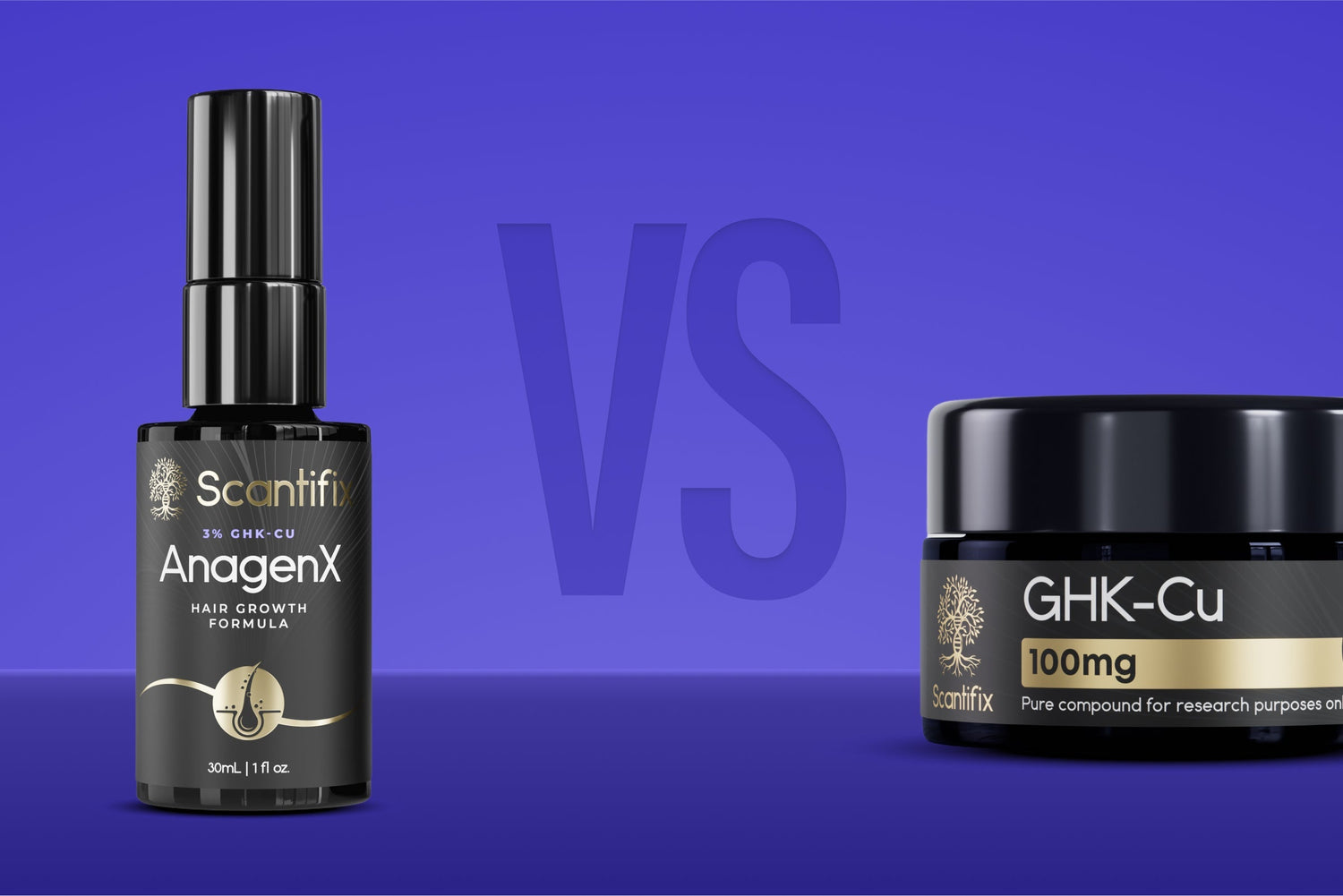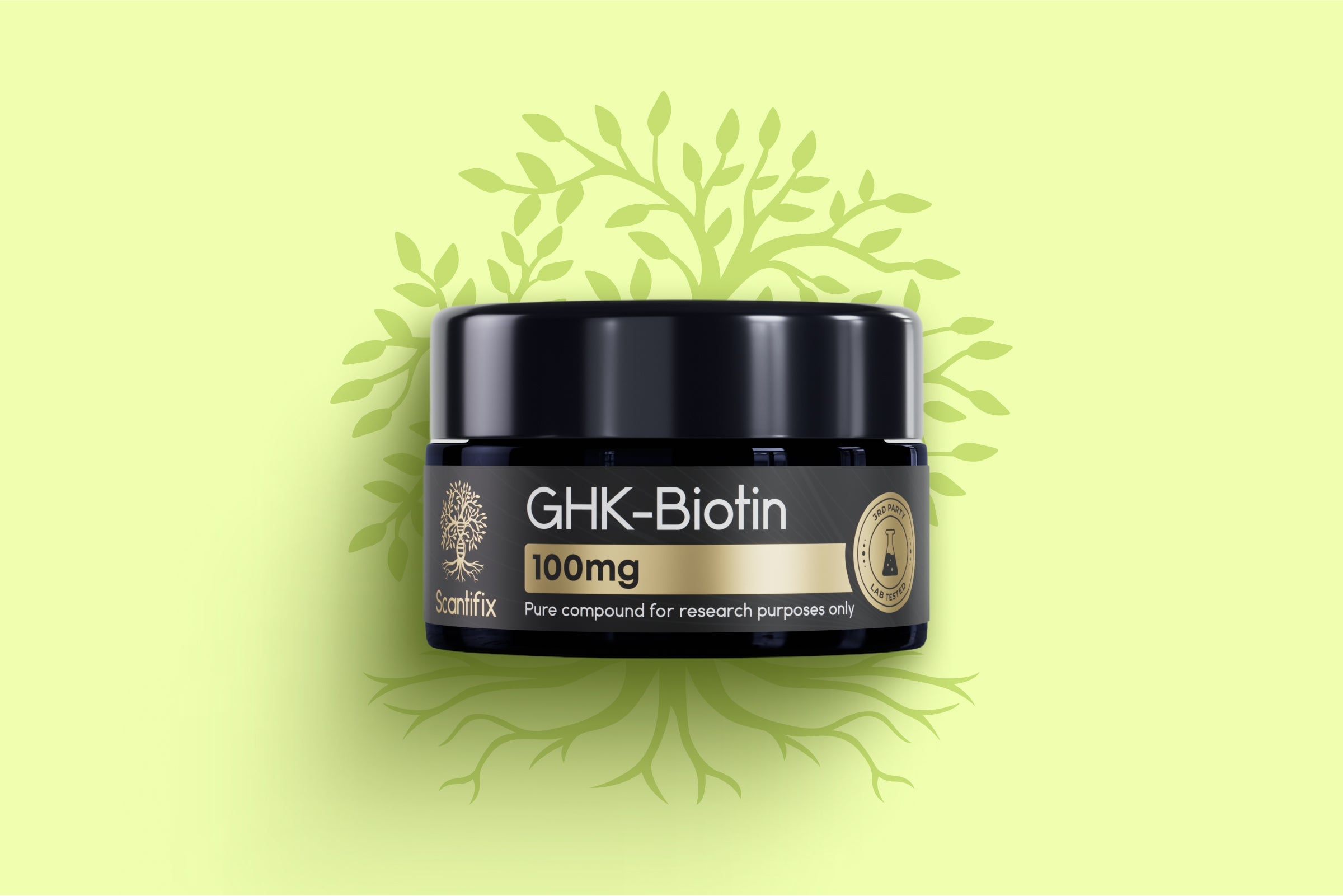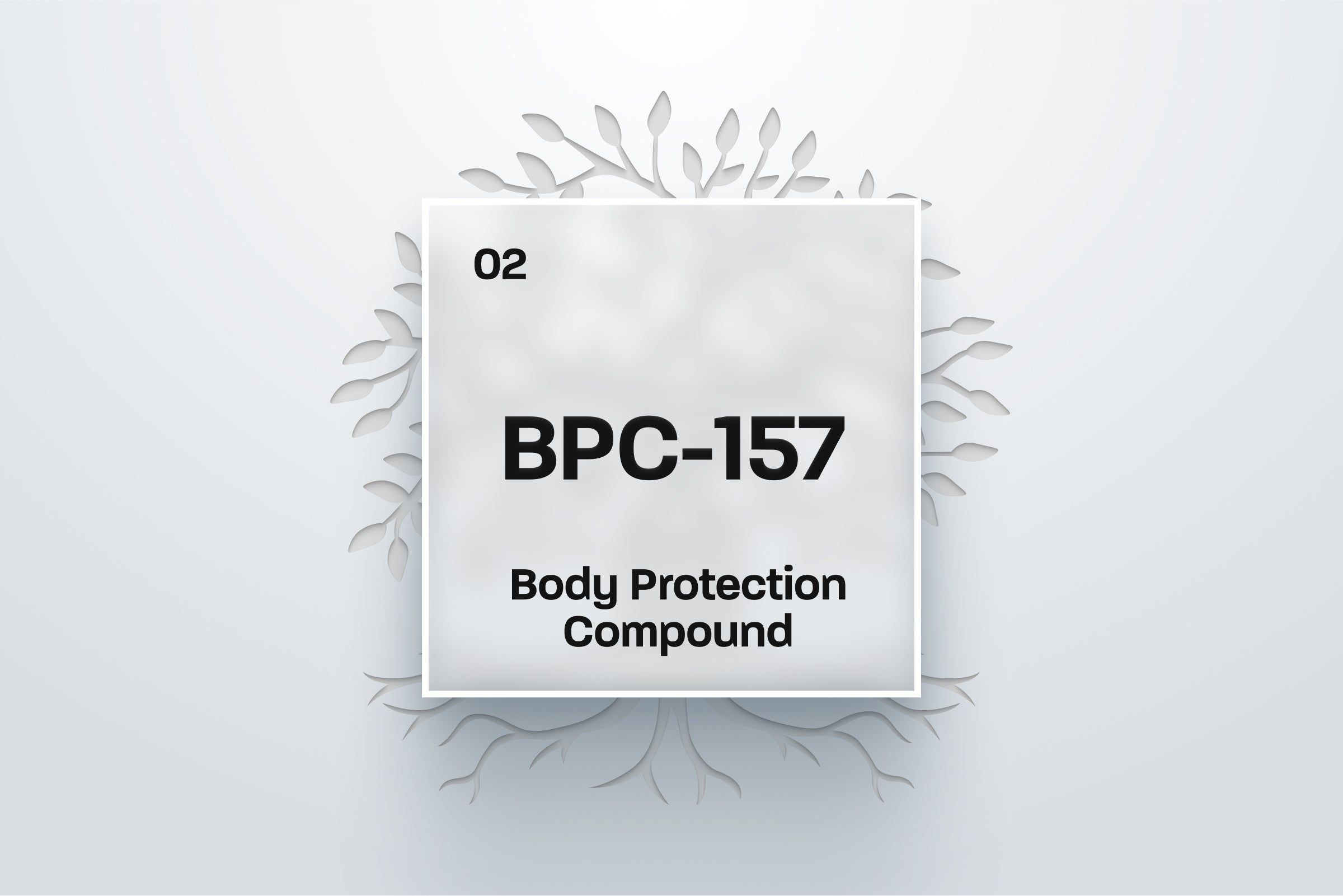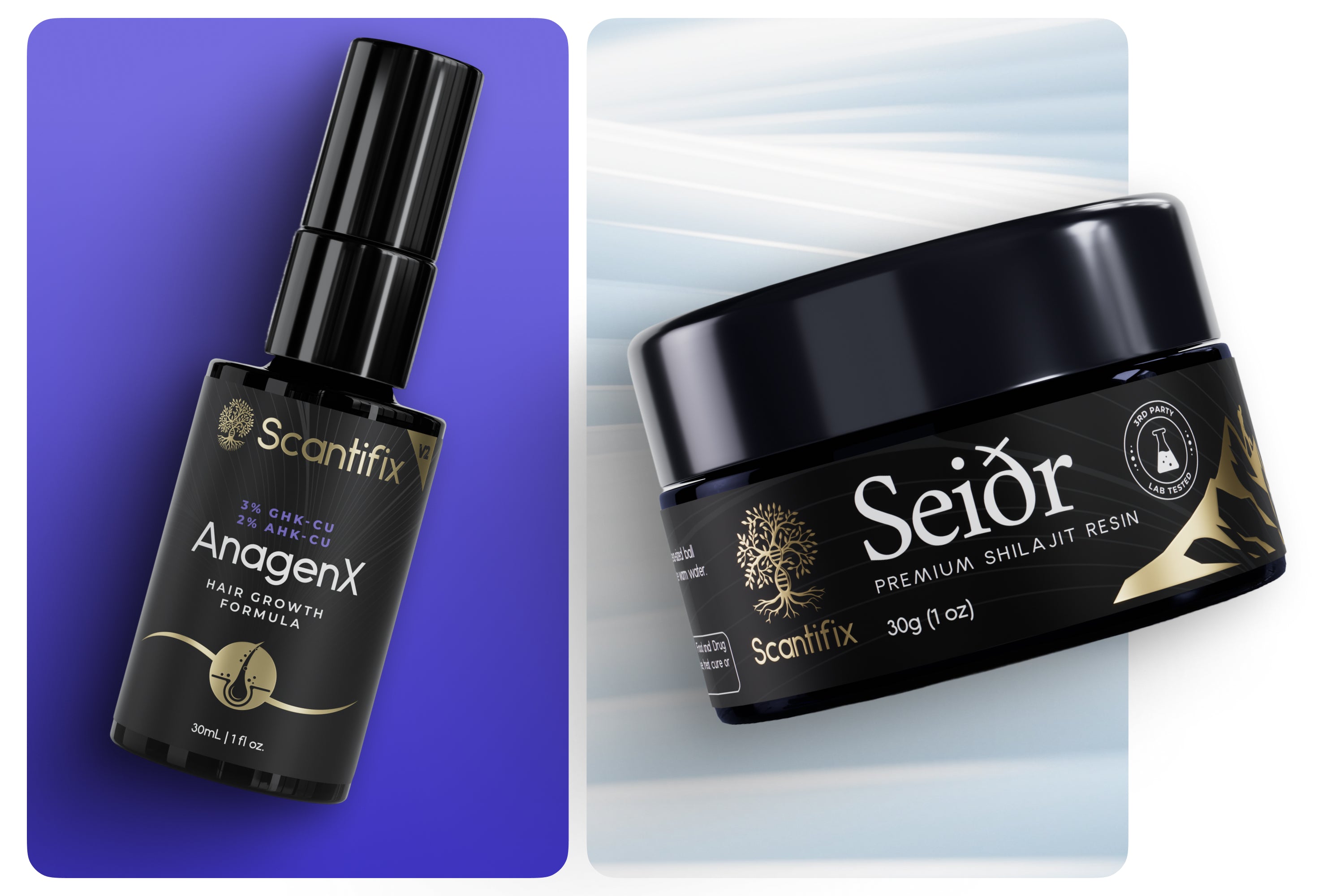When it comes to improving hair growth and scalp health, few ingredients have been as extensively studied or as well-established as the GHK-Cu peptide. This copper-based peptide has demonstrated regenerative effects across skin and hair applications, particularly for stimulating follicles, increasing hair density, and supporting wound repair.
But what if you could take those benefits further?
AnagenX, our multi-peptide serum, builds on the foundation of GHK-Cu by adding two additional peptides: BPC-157 and GHK-Biotin. Together, these three peptides for hair growth offer a more comprehensive and layered approach to restoring healthy hair and scalp function. In this blog, we’ll compare GHK-Cu on its own to the synergistic design of AnagenX—highlighting what each can do, and why this peptide trio could help unlock deeper, longer-term improvements in hair density and scalp function.
What Is GHK-Cu?
The GHK-Cu peptide is a copper-binding tripeptide (glycyl-L-histidyl-L-lysine) found naturally in the human body. As a signaling molecule, it plays a central role in tissue remodeling, wound healing, angiogenesis, and collagen synthesis, making it an essential part of skin and hair regeneration.
Among copper peptides for hair growth, GHK-Cu has been shown to:
-
- Stimulate dermal papilla cells, which are critical for initiating new follicle growth (Pyo et al., 2007)
- Increase follicle size and shift dormant follicles into the anagen (growth) phase (Pyo et al., 2007)
- Promote the production of glycosaminoglycans and collagen, improving scalp health and structure (Pickart & Margolina, 2018)
- Reduce pro-inflammatory markers like IL-6 and TNF-alpha, calming the environment around follicles (Pickart et al., 2015)
- Enhance vascularization, ensuring oxygen and nutrients reach the follicle root (Dou, 2020)
These actions help explain why GHK-Cu is considered one of the most effective peptides in regenerative dermatology. Its well-documented biological roles extend beyond the scalp to include anti-aging effects, oxidative stress reduction, and skin barrier repair (Pickart et al., 2015; Wang et al., 2024).
What Is AnagenX?
AnagenX is a science-backed hair and scalp treatment formulated with peptides to target hair health from multiple angles. It contains three ingredients: GHK-Cu, BPC-157, and GHK-Biotin. Together, they address the structural, environmental, and regenerative dimensions of healthy hair growth.
What sets AnagenX apart:
-
- High purity, third-party tested peptides at active concentrations, including 100% pure GHK-Cu.
- Transparent ingredients, with no fillers, irritants, or unlisted additives
- Packaged in light-filtering MIRON Violetglass to preserve potency and efficacy of peptides
- Designed for long-term scalp compatibility and easy daily use
The formulation is based on the idea that hair loss is a very complex problem, involving both follicle and scalp health. Inflammation, circulation, oxidative stress, and barrier damage all contribute to poor hair quality and thinning. By combining peptides with complementary mechanisms, AnagenX is formulated to create a layered effect that amplifies their impact. The result is greater than what any single peptide could deliver in isolation.
Peptide Breakdown: What Each One Brings to the Table
GHK-Cu
As discussed above, GHK-Cu is a central component of both AnagenX and many standalone treatments. Its regenerative actions are well-supported by decades of data, including:
-
- Increased follicle density
- Reversal of miniaturization in hair follicles
- Improved wound healing and scalp barrier resilience (Pickart & Margolina, 2018; Pyo et al., 2007)
In one clinical study, topical application of GHK-Cu was associated with a ~27% increase in hair density and up to 70% reduction in shedding within three months (Pickart & Margolina, 2018).
BPC-157
BPC-157 is a newer synthetic peptide derived from a protective protein in the gut. Initial research has shown early promise in for its regenerative and anti-inflammatory effects. Preclinical studies have shown anti-inflammatory, angiogenic, and wound-healing properties, supporting its potential to reduce localized inflammation and improve blood flow.
These BPC-157 peptide benefits may help create a more favorable environment for hair follicles to function and recover—especially in cases of inflammation-related shedding or stress-triggered hair loss.
GHK-Biotin
GHK-Biotin (also called Biotinoyl Tripeptide-1) is a hybrid molecule combining GHK with biotin, a B-vitamin essential for keratin infrastructure. One early study reported that GHK-Biotin:
-
- Increased the anagen/telogen ratio, indicating a higher percentage of follicles in the active growth phase
- Upregulated Ki-67, a marker of cell proliferation in cultured hair follicles—an early signal of increased follicular activity that may support stronger regrowth over time
- Resulted in visibly improved hair density and increased follicular activity in men with alopecia when applied topically at 10 ppm for four months (Active Peptide Company, 2014)
These effects suggest that GHK-Biotin may help anchor hair at the root, strengthen keratin synthesis, and support regrowth, particularly when paired with other regenerative peptides.
Why Choose Peptides Over Traditional Hair Loss Treatments?
Unlike pharmaceutical hair loss treatments, which may involve hormonal side effects or require continued use to sustain results, peptides offer a gentler and biologically guided approach. Rather than forcing changes, they work by supporting the body’s natural signaling and repair pathways—often with fewer risks and better skin compatibility. This makes peptides an attractive option for those looking to strengthen hair health without harsh interventions (Suchonwanit et al., 2019; Mysore, 2012).
Why These Peptides Work Better Together
Each peptide for hair growth in AnagenX brings a distinct mechanism of action:
-
- GHK-Cu stimulates follicular regeneration, encourages collagen and blood vessel growth, and repairs scalp tissue (Pickart & Margolina, 2018)
- BPC-157 helps calm inflammation and improve circulation, creating the conditions necessary for repair
- GHK-Biotin strengthens strands and supports follicle anchoring, helping new growth remain strong and stable (Active Peptide Company, 2014)
Used together, they form a comprehensive system that targets hair health from multiple levels: the follicle, the scalp environment, and the structural support network around the strand. This multi-pathway approach mimics how the body heals naturally—layered, cooperative, and adaptive.
When to Choose GHK-Cu vs. AnagenX
For those seeking a targeted and well-researched approach to stimulating hair follicles, GHK-Cu alone may be a smart starting point, particularly for minimalists or those with isolated thinning.
However, if you’re experiencing complex hair health challenges, such as inflammation, shedding, scalp sensitivity, or early signs of pattern loss, AnagenX offers a broader support system. It layers GHK-Cu’s regenerative power with BPC-157’s inflammation-calming properties and GHK-Biotin’s structural reinforcement for a more well-rounded effect.
Ultimately, the right choice depends on your goals, your skin, and how your scalp responds over time.
Final Thoughts: Comparing Two Paths to Healthier Hair
GHK-Cu has set a high standard in regenerative science, and for good reason. It’s effective, well tolerated, and deeply studied. But AnagenX offers a more advanced approach by combining the proven strengths of GHK-Cu with newer, synergistic peptides that work synergistically to restore hair vitality from every angle.
Both options respect the body’s natural biology. Both avoid harsh drugs or risky procedures. And both offer a thoughtful, science-guided way to support the hair you have and the hair you want to grow.
References
Active Peptide Company. (2014). Biotin-GHK in hair follicle and hair loss: Scientific presentation. https://www.activepeptide.com/wp-content/uploads/2014/06/Biotin-GHK-Presentation-Active-Peptide-Company.pdf
Dou, Y. (2020). The potential of GHK as an anti-aging peptide. Aging Pathobiology and Therapeutics, 2(3), 139–143. https://pmc.ncbi.nlm.nih.gov/articles/PMC8789089/?utm_source=chatgpt.com
Mysore, V. (2012). Finasteride in androgenetic alopecia: An update. Journal of Cutaneous and Aesthetic Surgery, 5(1), 17–19. https://www.ncbi.nlm.nih.gov/pmc/articles/PMC3481923/
Pickart, L., Margolina, A., & Moyer, K. E. (2015). The human tripeptide GHK-Cu in prevention of oxidative stress and cancer. Oxidative Medicine and Cellular Longevity, 2015, 1–10. https://pmc.ncbi.nlm.nih.gov/articles/PMC4508379/
Pickart, L., Margolina, A., & Vasquez-Soltero, J. M. (2015). GHK-Cu may prevent oxidative stress in skin by regulating copper and iron levels. Cosmetics, 2(3), 236–247. https://www.mdpi.com/2079-9284/2/3/236
Pickart, L., & Margolina, A. (2018). Regenerative and protective actions of the GHK-Cu peptide in the light of the new gene data. International Journal of Molecular Sciences, 19(7), 1987. https://www.mdpi.com/1422-0067/19/7/1987
Pyo, H. K., Yoo, H. G., Won, C. H., Lee, S. H., Kang, Y. J., Chung, J. H., & Eun, H. C. (2007). The effect of tripeptide-copper complex on human hair growth in vitro. Archives of Pharmacal Research, 30(7), 834–839. https://link.springer.com/article/10.1007/BF02978833
Suchonwanit, P., Thammarucha, S., & Leerunyakul, K. (2019). Minoxidil and its use in hair disorders: A review. Drug Design, Development and Therapy, 13, 2777–2786. https://doi.org/10.2147/DDDT.S214907
Wang, S., Ma, X., Li, J., Lin, Y., & Liu, Y. (2024). GHK-Cu-pionin loaded in situ electrospun PVB/PVP smart dressings with antioxidant and antibacterial properties. Chemical Engineering Journal, 481, 149757. https://www.sciencedirect.com/science/article/abs/pii/S1385894724036416?via%3Dihub







Leave a comment
All comments are moderated before being published.
This site is protected by hCaptcha and the hCaptcha Privacy Policy and Terms of Service apply.